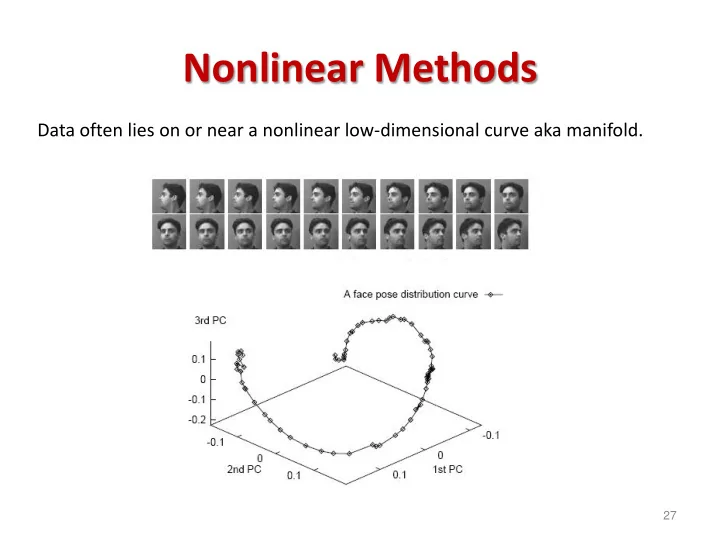

Nonlinear Methods Data often lies on or near a nonlinear low-dimensional curve aka manifold. 27
Laplacian Eigenmaps Linear methods – Lower-dimensional linear projection that preserves distances between all points Laplacian Eigenmaps (key idea) – preserve local information only Project points into a low-dim Construct graph from data points space using “eigenvectors of (capture local information) the graph”
Step 1 - Graph Construction Similarity Graphs: Model local neighborhood relations between data points G(V,E) V – Vertices (Data points) (1) E – Edge if ||xi – xj|| ≤ ε ε – neighborhood graph (2) E – Edge if k-NN, yields directed graph connect A with B if A → B OR A ← B (symmetric kNN graph) connect A with B if A → B AND A ← B (mutual kNN graph) Directed nearest neighbors (symmetric) kNN graph mutual kNN graph
Step 1 - Graph Construction Similarity Graphs: Model local neighborhood relations between data points Choice of ε and k : Chosen so that neighborhood on graphs represent neighborhoods on the manifold (no “shortcuts” connect different arms of the swiss roll) Mostly ad-hoc
Step 1 - Graph Construction Similarity Graphs: Model local neighborhood relations between data points G(V,E,W) V – Vertices (Data points) E – Edges (nearest neighbors) W - Edge weights E.g. 1 if connected, 0 otherwise (Adjacency graph) Gaussian kernel similarity function (aka Heat kernel) s 2 →∞ results in adjacency graph
Step 2 – Embed using Graph Laplacian • Graph Laplacian (unnormalized version) . L = D – W W – Weight matrix D – Degree matrix = diag ( d 1 , …. , d n ) Note: If graph is connected, 1 is an eigenvector
Step 2 – Embed using Graph Laplacian • Graph Laplacian (unnormalized version) L = D – W Solve generalized eigenvalue problem Order eigenvalues 0 = l 1 ≤ l 2 ≤ l 3 ≤ … ≤ l n To embed data points in d-dim space, project data points onto eigenvectors associated with l 2 , l 3 , …, l d+1 ignore 1 st eigenvector – same embedding for all points Original Representation Transformed representation data point projections x i → (f 2 (i ), …, f d+1 (i)) (D-dimensional vector) (d-dimensional vector)
Understanding Laplacian Eigenmaps • Best projection onto a 1-dim space – Put all points in one place (1 st eigenvector – all 1s) – If two points are close on graph, their embedding is close (eigenvector values are similar – captured by smoothness of eigenvectors) Laplacian eigenvectors of swiss roll example (for large # data points)
Step 2 – Embed using Graph Laplacian • Justification – points connected on the graph stay as close as possible after embedding RHS = f T (D-W) f = f T D f - f T W f = LHS
Step 2 – Embed using Graph Laplacian • Justification – points connected on the graph stay as close as possible after embedding constraint removes arbitrary scaling factor in embedding Wrap constraint into the Lagrangian: objective function
Example – Unrolling the swiss roll N=number of nearest neighbors, t = the heat kernel parameter (Belkin & Niyogi’03)
Example – Understanding syntactic structure of words • 300 most frequent words of Brown corpus • Information about the frequency of its left and right neighbors (600 Dimensional space.) verbs • The algorithm run with N = 14, t = 1 prepositions
PCA vs. Laplacian Eigenmaps PCA Laplacian Eigenmaps Linear embedding Nonlinear embedding based on largest eigenvectors of based on smallest eigenvectors of D x D correlation matrix S = XX T n x n Laplacian matrix L = D – W between features between data points eigenvectors give latent features eigenvectors directly give - to get embedding of points, embedding of data points project them onto the latent features x i → [v 1T x i , v 2T x i , … v dT x i ] T x i → [f 2 (i ), …, f d+1 (i)] T D x1 d x1 D x1 d x1
Dimensionality Reduction Methods • Feature Selection - Only a few features are relevant to the learning task Score features (mutual information, prediction accuracy, domain knowledge) Regularization • Latent features – Some linear/nonlinear combination of features provides a more efficient representation than observed feature Linear: Low-dimensional linear subspace projection PCA (Principal Component Analysis), MDS (Multi Dimensional Scaling), Factor Analysis, ICA (Independent Component Analysis) Nonlinear: Low-dimensional nonlinear projection that preserves local information along the manifold Laplacian Eigenmaps ISOMAP, Kernel PCA, LLE (Local Linear Embedding), Many, many more … 40
Recommend
More recommend